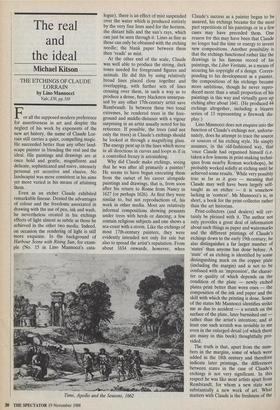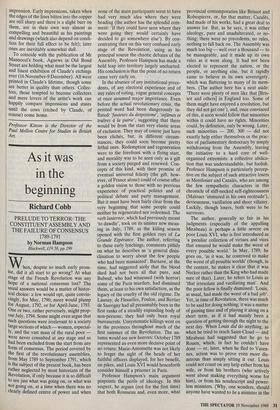The real and the ideal
Michael Kitson
THE ETCHINGS OF CLAUDE LORRAIN by Lino Mannocci Yale, £50, pp.310 For all the supposed modern preference for assertiveness in art and despite the neglect of his work by exponents of the new art history, the name of Claude Lor- rain still carries a quiet, compelling magic. He succeeded better than any other land- scape painter in blending the real and the ideal. His paintings and drawings are at once bold and gentle, magnificent and delicate, sophisticated and naive, intensely personal yet secretive and elusive. No landscapist was more consistent in his aims yet more varied in his means of attaining them.
Even as an etcher Claude exhibited remarkable finesse. Denied the advantages of colour and the freedoms associated in drawing with the use of pen, ink and wash, he nevertheless created in his etchings effects of light almost as subtle as those he achieved in the other two media. Indeed, on occasion the rendering of light is still more exquisite. In the background of Harbour Scene with Rising Sun, for exam- ple (No. 15 in Lino Mannocci's cata- logue), there is an effect of mist suspended over the water which is produced entirely by the very fine lines used for the horizon, the distant hills and the sun's rays, which can just be seen through it. Lines as fine as these can only be obtained with the etching needle; the blank paper between them then `reads' as mist.
At the other end of the scale, Claude was well able to produce the strong, dark tones needed for foreground figures and animals. He did this by using relatively broad lines placed close together and overlapping, with further sets of lines crossing over them, in such a way as to produce a dense, furry blackness unsurpas- sed by any other 17th-century artist save Rembrandt. In between these two tonal extremes, he rendered trees in the fore- ground and middle-distance with a vigour surprising in an artist usually noted for his reticence. If possible, the trees (and not only the trees) in Claude's etchings should be looked at through a magnifying glass. The energy pent up in the lines which move in all directions in curves and loops as if in a controlled frenzy is astonishing.
Why did Claude make etchings, seeing that he was after all primarily a painter? He seems to have begun executing them from the outset of his career alongside paintings and drawings, that is, from soon after his return to Rome from Nancy in 1627 (or perhaps 1626). At first they were similar to, but not reproductions of, his work in other media. Most are relatively informal compositions showing peasants under trees with herds or dancing; a few contain religious subjects and one shows a sea-coast with a storm. Like the etchings of most 17th-century painters, they were evidently intended not only for sale but also to spread the artist's reputation. From about 1634 onwards, however, when Time, Apollo and the Seasons, 1662 Claude's success as a painter began to be assured, his etchings became for the most part repetitions of his paintings or in a few cases may have preceded them. One reason for this may have been that Claude no longer had the time or energy to invent new compositions. Another possibility is that the etchings functioned rather like the drawings in his famous record of his paintings, the Liber Veritatis, as a means of securing his copyright of a design. Corres- ponding to his development as a painter, the compositions of his etchings became more ambitious, though he never repro- duced more than a small proportion of his paintings in this way and virtually gave up etching after about 1641. (He produced 44 etchings altogether, including a bizarre series of 13 representing a firework dis- play.) Lino Mannocci does not enquire into the function of Claude's etchings nor, unfortu- nately, does he attempt to trace the source or sources of his etching style. He simply assumes, in the old-fashioned way, that `once Claude had organised himself (i.e. taken a. few lessons in print-making techni- ques from nearby Roman workshops), he probably worked solidly at etching until he achieved some results.' While very possibly true as far as it goes — meaning that Claude may well have been largely self- taught as an etcher — it is somehow lacking in 'context'. Mr Mannocci's is, in short, a book for the print-collector rather than the art historian.
Print-collectors (and dealers) will cer- tainly be pleased with it. The author not only provides a great deal of information about such things as paper and watermarks and the different printings of Claude's etchings down to the early 19th century; he also distinguishes a far larger number of `states' than anyone has done before. A `state' of an etching is identified by some distinguishing mark on the copper plate (including the margin) and is not to be confused with an 'impression', the charac- ter or quality of which depends on the condition of the plate — newly etched plates print better than worn ones — the composition of the ink and paper and the skill with which the printing is done. Some of the states Mr Mannocci identifies strike me as due to accident — a scratch on the surface of the plate, later burnished out rather than the artist's intention; and at least one such scratch was invisible to me even in the enlarged detail (of which there are many in this book) thoughtfully pro- vided.
The truth is that, apart from the num- bers in the margins, some of which were added in the 18th century and therefore indicate later printings, the differences between states in the case of Claude's etchings is not very significant. In this respect he was like most artists apart from Rembrandt, for whom a new state was substantially a new work of art. What matters with Claude is the freshness of the impression. Early impressions, taken when the edges of the lines bitten into the copper are still sharp and there is a slight burr on them, are in their own way almost as compelling and beautiful as his paintings and drawings (which also depend on condi- tion for their full effect to be felt); later ones are inevitably somewhat dull. To coincide with the publication of Mr Mannocci's book, Agnews in Old Bond Street are holding what must be the largest and finest exhibition of Claude's etchings ever (16 November-9 December). All were printed in Claude's lifetime, though some are better in quality than others. Collec- tors, those tempted to become collectors and mere lovers of the artist's work can happily compare impressions and states until the cows (etched by Claude, of course) come home.
Professor Kitson is the Director of the Paul Mellon Centre for Studies in British Art,























































 Previous page
Previous page